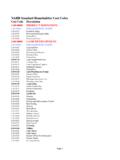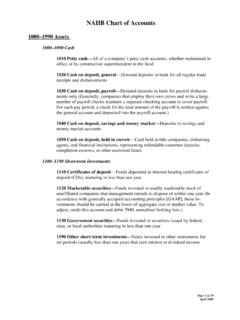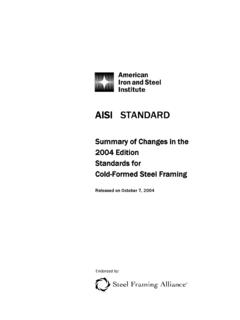Transcription of Structural Design Loads foe One- and Two- Family Dwellings
1 Department of Housing and Urban DevelopmentOffice of Policy Development and Research SSttrruuccttuurraall DDeessiiggnn LLooaaddss ffoorr OOnnee--aanndd TTwwoo--FFaammiillyy DDwweelllliinnggss PATH (Partnership for Advancing Technology in Housing) is a new private/public effort to develop, demonstrate, and gain widespread market acceptance for the Next Generation of American housing. Through the use of new or innovative technologies, the goal of PATH is to improve the quality, durability, environmental efficiency, and affordability of tomorrow s homes. PATH, initiated jointly by the Administration and Congress, is managed and supported by the Department of Housing and Urban Development (HUD).
2 In addition, all Federal Agencies that engage in housing research and technology development are PATH Partners, including the Departments of Energy and Commerce, as well as the Environmental Protection Agency (EPA) and the Federal Emergency Management Agency (FEMA). State and local governments and other participants from the public sector are also partners in PATH. Product manufacturers, home builders, insurance companies, and lenders represent private industry in the PATH Partnership. To learn more about PATH, please contact: 451 7th Street, SW Suite B 133 Washington, DC 20410 202-708-5873 (fax) e-mail: website: Visit PD&R's Web Site to find this report and others sponsored by HUD's Office of Policy Development and Research (PD&R).
3 Other services of HUD USER, PD&R's Research Information Service, include listservs; special interest, bimonthly publications (best practices, significant studies from other sources); access to public use databases; hotline 1-800-245-2691 for help accessing the information you need. Structural Design Loadsfor One- and Two- Family DwellingsStructural Design Loads for One- and Two- Family Dwellings Prepared for Department of Housing and Urban Development Office of Policy Development and Research Washington, DC Contract H-21172CA and National Association of Home Builders Program for Research and Optimum Value Engineering Washington, DC by NAHB Research Center, Inc. Upper Marlboro, Maryland May 2001 Acknowledgments This document was prepared by the NAHB Research Center, Inc.
4 The work was cooperatively sponsored by the Department of Housing and Urban Development (HUD) and the National Association of Home Builders (NAHB). Appreciation is extended to the following individuals whose comments and critical review served to improve this work: Eric Burnett, , Director, Pennsylvania Housing Research Center (Penn State University) Helen English, Executive Director, Sustainable Building s Industry Council William Freeborne, . Department of Housing and Urban Development Lee Golanoski, Assistant Director of Architecture, Toll Brothers, Inc. Peter L. Pfeiffer, Principal, Barley and Pfeiffer Architects David V. Rosowsky, , Oregon State University Jim Rossberg, American Soc iety of Civil Engineers Andrea Vrankar, PE, RA, Department of Housing and Urban Development NOTICE The work that provided the basis for this publication was supported by funding under a grant with the Department of Housing and Urban Development.
5 The substance and findings of the work are dedicated to the public. The author is solely responsible for the accuracy of the statements and interpretations contained in this publication. Such interpretations do not necessarily reflect the views of the Government. Whi le the information in thi s document is believed to be accurate, neithe r the authors, nor reviewers, nor the Department of Housing and Urban Development, nor the NAHB Research Center, Inc., nor any of their employees or representatives makes any warranty, gua rantee, or representation, expressed or implied, with respect to the accuracy, effectiveness, or usefulness of any information, method, or material in this document, nor assumes any liability for the use of any information, methods, or materials disclosed herein, or for damages arising from such use.
6 This publication is intended for use by professionals who are competent to eva luate the significanc e and limitations of the reported information. ABOUT THE NAHB RESEARCH CENTER, INC. The NAHB Research Center is a not-for-profit subsidiary of the National Association of Home Builders (NAHB). The NAHB has 200,000 members, including 50,000 builders who build more than 80 percent of new American homes. NAHB Research Center conducts research, analysis, and demonstration programs in all areas relating to home building and carries out extensive programs of information dissemination and interchange among members of the industry and between the industry and the public.
7 Ii Structural Design Loads for One- and Two- Family Dwellings Preface This guide serves the express purpose of promoting a practical and technically sound method of determining Design Loads for typical residential construction in the United States. The scope, therefore, is limited to single- Family attached and detached buildings. It is intended to advance residential building Design by unifying the current practice of applying Design Loads , improving the level of efficienc y in the Design effor t, and promoting cost-effective results. Therefore, thi s gui de serves as a resource document for residential buildi ng designers and as a simple model for reasonable determination of Design Loads for low-rise residential buildings.
8 Structural Design Loads for One- and Two- Family Dwellings is based on a compilation and simplification of best practices for the Design and construction of homes in the United States. It is intended to supplement current standards of Design such as found in national model building codes and Design standards such as Minimum Design Loads for Buildings and Other Structures (ASCE 7-98)1 . The scope of current standards of Design typically encompass such a breadth of applications that it is often difficult for designers to make simple and effective applications to residential buildings. Similarly, unique technical considerations on Design Loads for housing are often overlooked in generalized Design criteria.
9 This guide is based on current practices as represented in ASCE 7-98, but it also contains relevant technical information from newer resources such as the Residential Structural Design Guide2 as well as older resources such as ANSI , the Minimum Property Standards4, and Light Frame House Construction5. International methods of determining residential Design Loads were are also considered, such as Wind Loads for Housing6 and Residential Timber-Framed Construction, Part 1 Design Criteria7 . While this document is written in a regulatory style, it is not a consensus standard that is cur rently referenced in any existing local, state, or national model building code in the United States.
10 Therefore, the designer is encouraged to become fully aware of any potential differences from local regul ations prior to considering the use of this guide as an alterna te means or method of Design . 1 Minimum Design Loads for Buildings and Other Structures, ASCE Standard 7-9 8, American Society of Civil Engineers, Reston, VA, 1999. 2 Residential Structural Design Guide: 2000 Edition, prepare d for the Depart ment of Housing and Urban Development by NAHB Research Center, Inc., Upper Marlboro, MD, 2000. 3 Minimum Design Loads for Buildings and Other Structures, ANSI , American National Standards Institute, New York, NY, 1982. 4 Minimum Property Standards, Federa l Housing Administra tion, Washington, DC, 1958.




